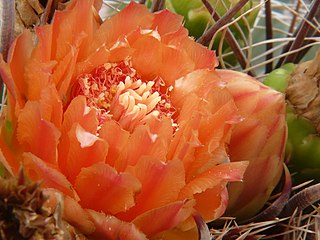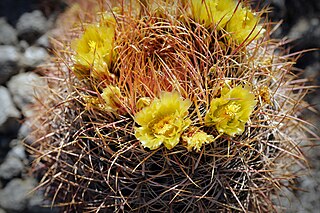
Echinocereus engelmannii, the strawberry hedgehog cactus or Engelmann's hedgehog cactus, is a cactus commonly found in desert areas of the southwestern United States and the adjacent areas of Mexico, including the states of California, Nevada, Utah, Arizona, Baja California and Sonora.

Stenocereus thurberi, the organ pipe cactus, is a species of cactus native to Mexico and the United States. The species is found in rocky desert. Two subspecies are recognized based on their distribution and height. The Organ Pipe Cactus National Monument is named for the species. Cacti are minimally adapted to particular thermal niches, and are tremendously vulnerable to seasonal precipitation.

Echinocereus reichenbachii is a perennial plant and shrub in the cactus family. The species is native to the Chihuahuan Desert and parts of northern Mexico and the southern United States, where they grow at elevations up to 1,500 meters (4,900 ft). This cactus earned the Royal Horticultural Society's Award of Garden Merit.

Turbinicarpus pseudopectinatus is a species of plant in the family Cactaceae.

Ferocactus wislizeni, the fishhook barrel cactus, also called Arizona barrel cactus, candy barrel cactus, and Southwestern barrel cactus, is a species of flowering plant in the cactus family Cactaceae, native to northern Mexico and the southern United States. It is a ball-shaped cactus eventually growing to a cylindrical shape, with spiny ribs and red or yellow flowers in summer.

Ferocactus cylindraceus is a species of barrel cactus which is known by several common names, including California barrel cactus, Desert barrel cactus, compass barrel cactus, and miner's compass. It was first described by George Engelmann in 1853.

Pelecyphora vivipara is a species of cactus known by several common names, including spinystar, viviparous foxtail cactus, pincushion cactus and ball cactus. It is native to North America, where certain varieties can be found from Mexico to Canada. Most of these varieties are limited to the Mojave and Sonoran Deserts. The species epithet "vivipara" is due to the species' viviparous reproductive habit.

Echinocereus fendleri is a species of cactus known by the common names pinkflower hedgehog cactus and Fendler's hedgehog cactus. It is named in honor of Augustus Fendler.

Echinocereus viridiflorus is a species of cactus known by the common names nylon hedgehog cactus, green pitaya, and small-flowered hedgehog cactus. It is native to the central and south-central United States and northern Mexico, where it can be found in varied habitat types, including desert scrub, woodlands, dry grasslands, and short-grass prairie.

Sclerocactus sileri, the Siler fishhook cactus, is a rare and very small cactus found mostly in mineral-rich desert areas of intermediate elevations, notably in the American states of Utah, Nevada, and northern Arizona.

Ferocactus emoryi, known commonly as Emory's barrel cactus, Coville's barrel cactus and traveler's friend, is a barrel cactus in the genus Ferocactus.

Echinocereus poselgeri, also known as the dahlia cactus, is a species of Echinocereus. It is native to Coahuila and southern Texas.

Echinocereus pentalophus, with the common name ladyfinger cactus, is a species of Echinocereus cactus, in the tribe Echinocereeae Tribe. It is native to North America.

Echinocereus arizonicus is a species of cactus native to the Chihuahuan Desert region of Chihuahua, southwestern New Mexico and southeastern Arizona, as well as in the Superstition and Mescal Mountains of Central Arizona at elevations between 1400 to 1900 meters.

Cochemiea boolii is a species of cactus in the subfamily Cactoideae with pink-petaled flowers.

Echinocereus fasciculatus, commonly known as pinkflower hedgehog cactus, is a clumping cactus (Cactaceae) with brilliant magenta flowers and long spines found in the Sonoran Desert.

Echinocereus coccineus is a species of hedgehog cactus. Its native to Northern and Central America. It grows on full sun, in sandy or rocky well-drained soil. It can survive in hardiness zones 8–11.

Echinocereus bonkerae, also known as pinkflower hedgehog cactus, Bonker hedgehog, or short spined strawberry cactus, is a species of hedgehog cactus.

Pelecyphora macromeris, the nipple beehive cactus, is a species of cactus in the United States and Mexico. In the Chihuhuan Desert, it is common and has a wide range.

Cochemiea wrightii is a species of Cochemiea found in Mexico and the southern United States.























